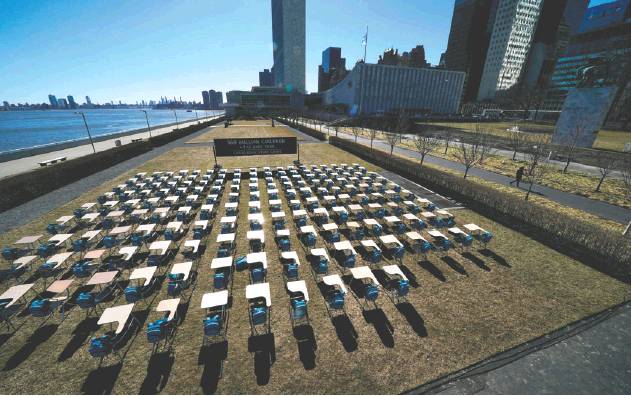Teacher vaccine plan fails to unite
While unions applaud Biden’s shift in priority, critics say it’s too late in the school year to matter
BY MORIAH BALINGIT, LAURA MECKLER AND DONNA ST. GEORGE
In school systems where classrooms remain shuttered, or where children may only attend school once or twice a week, President Biden hopes his move to press states into prioritizing teachers for coronavirus vaccination will help them move toward normalcy.
But his announcement Tuesday — and his pledge to make vaccination available to all educators and day-care workers by the end of March — was met with mixed emotions. Union leaders, who had lobbied hard for the move, applauded the action. But critics charged it comes far too late in the school year to make much of a difference for schoolchildren.
Biden’s pledge to reopen most schools that offer kindergarten through eighth grade within his first 100 days in office was one of his signature campaign promises. He has proposed giving schools $130 billion as part of a virus aid package, including $50 billion to prevent the layoff of teachers in school systems that are anticipating steep budget cuts.
“Let’s treat in-person learning like an essential service that it is,” Biden said in his address Tuesday. “And that means getting essential workers who provide that service — educators, school staff, childcare workers — get them vaccinated immediately. They’re essential workers.”
But his administration has stopped short of telling schools that teachers should be vaccinated before returning to classrooms, though the Centers for Disease Control and Prevention recommended that teachers be vaccinated. Before the announcement, 30 states prioritized teachers for vaccination.
In a directive sent to states on Tuesday, the Department of Health and Human Services said prioritizing educators was now a requirement for participation in the federal vaccine program. In the notice, HHS says educators are “critical to the continued functioning of society” and yet “it has come to our attention that some states have not considered teachers, school staff, and child care workers to be currently eligible to receive COVID-19 vaccine.”
By Wednesday, several states — including Pennsylvania, New Jersey, Massachusetts and Washington — moved to prioritize teachers, allowing educators in those states to start making appointments as soon as next week.
It was still unclear, though, how much of an effect on school reopening plans it would have. Many of the states that have not prioritized teachers for vaccination reopened schools before shots were available for anyone.
Other school systems, like Philadelphia Public Schools, came to an agreement with teachers over classroom conditions, and did not plan to deviate from that because of the announcement. Philadelphia’s teachers were already eligible for vaccines through a program set up by the Children’s Hospital of Philadelphia. And some states already have robust efforts to vaccinate teachers.
In New Jersey, where teachers unions have clashed with school districts over reopening, officials predicted that vaccine availability would give a jolt to reopening.
“I think it’s going to make a huge difference,” said Marie Blistan, president of the New Jersey Education Association, which represents 200,000 school employees in the state.
The Montclair, N.J., school district, which has been unable to reopen partly because of teacher opposition, also welcomed the announcements.
“The District supports the vaccination of all educators. It is our sincere hope that the prioritization of vaccines for teachers and school staff will assist the District in reopening to in-person instruction as soon as possible,” said Superintendent Jonathan Ponds, who sued the teachers union over its refusal to return to classrooms.
But many remained frustrated about the timing. If teachers are vaccinated according to Biden’s timeline, many would not get their second dose until mid-April. For students whose school year ends in May, that might be too late.
States have used a variety of approaches in vaccinating teachers, with some using it as leverage to force schools to open their doors.
In Ohio, state officials are ahead of the curve, with a fourweek push in February that vaccinated virtually all school employees interested in getting the shots. More than 200,000 first doses were administered and many second doses, officials said — part of a deal that Gov. Mike DeWine (R) reached with school systems that agreed to offer in-person learning by March 1.
Every system but one signed the pledge, and almost all are open for some level of hybrid or full-week, in-person learning. Several urban systems, including Cleveland, are expected to reopen buildings for instruction in the coming weeks.
“We said: ‘Look, if you will go in person five days a week, or if you will go hybrid and make it available for everyone who wants to do it, we’ll vaccinate everyone in your school buildings who wants to be vaccinated, the adults,’ ” he said.
Amy Donofrio, a 34-year-old teacher in Jacksonville, Fla., said she wishes Biden would have taken this action sooner. Before Biden’s announcement, Florida said only teachers over the age of 50 were eligible for the vaccine.
“If it was a priority, it would have been his first move when he got in to office,” Donofrio said.
She has been frustrated by many aspects of the pandemic response, including that her district forced her to return to her classroom, where 35 or more students sit side by side.
“All politicians from both sides of the aisle have made it very clear where their value for teachers is this year and for that matter, their value for students,” she said. “It hasn’t felt like any of their lives have mattered to our government.”
